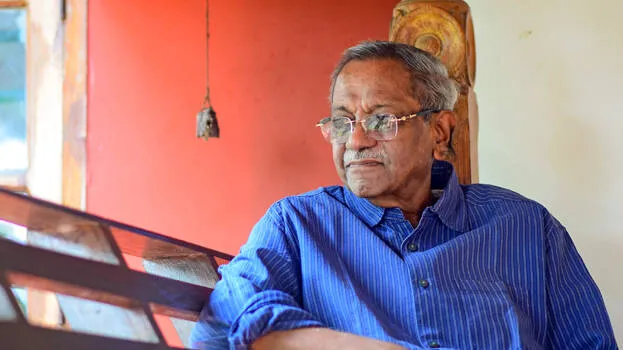

Mao Zedong's poem about rain is famous - Red, orange, yellow, green, blue, violet, indigo: Who is dancing with these rainbow colours in the sky? Air after rain, slanting sun: mountains and passes turning blue in each changing moment. Like the earth, the sky is a jewel of colours. Shaji N. Karun was a cinematographer and director who added the colour of imagination to the colours of both. Shaji's childhood lessons were the scenes that were seen day and night in the backwaters of Kandachira, Perinad, Kollam. They became his homework for cinematography in that mind. As Shaji grew up, his thoughts and investigations were about the unknown habitat of colours inside the camera and in the darkroom. That continuous investigation led him to drop out of the MBBS at the Thiruvananthapuram Medical College and study cinema at the Pune Film Institute.
If Shaji had to study medicine, we would have had an excellent doctor with skill and compassion. However, Shaji's destiny was to capture the colours and the colourfulness of life through the camera. That became a badge of honour for his birthplace Kerala and the whole of India for visual charm. We do not have many Malayalis who have reached the top of world cinema through direction and cinematography. Shaji N. Karun first became an independent cameraman in K.P. Kumaran's 'Lakshmivijayam'. He was only 24 at the time. Shaji's acquaintance with the talented director G Aravindan, who had come to Madras to work on 'Uttarayanam', changed the course of his life. Thus, Shaji N. Karun became the cameraman of Aravindan's Kanchana Sita.
Shaji's subsequent steps were as bright as a crimson. The Aravindan-Shaji partnership became a part of world cinema. Shaji was the cinematographer of all but Aravindan's first and last films. Shaji travelled the world film map as an independent director with 'Piravi'. Piravi, a story of the anguish of an elderly father, torn by worries about his missing son, also became a reflection of how politics crept into the depths of an ordinary family like a snake. 'Piravi' won several awards. Shaji's success did not come by chance. It was achieved through talent and hard work. No other Indian director has won more national and international awards than Shaji.
After 'Piravi', he directed seven films, namely Swaham, Vanaprastham, Nishad, Kutty Srank, Swapaanam and Oolu. The first three films, Piravi, Swaham and Vanaprastham, were screened at Cannes. Shaji did not believe that dialogue was the main focus of cinema. The linguistic sense of a cinematographer will not be that way. Shaji told the story through the camera. Perhaps 'Piravi' and 'Vanaprastham' were the most skilful attempts at this sensory technique in Malayalam. Shaji's cinematography was a combination of sun, wind, rain and lightning. Rather than natural phenomena, they were re-incarnated in the film as biological symbols that absorbed the emotions of the characters. When you see them on the screen, it seems that the camera is just running; but through those natural manifestations, the director was capturing the undercurrents of human emotions.
Shaji N. Karun's cinematography in Padmarajan's Koodevide?, Arappatta Kettiya Gramathil, Aravindan's Thampu, M.T.'s Manju, Hariharan's Nakhakshathangal, Panchagni and Sargam is worth mentioning. He won the National Award for Best Cinematography in Thampu. Shaji gave the role of the Kathakali actor in 'Vanaprastham' to Mohanlal. Vanaprastham portrayed the inner struggles of a stage artist. Everyone agrees that Kalamandalam Krishnan Nair was the best Kathakali artist to exist. Mohanlal had the same physique and look. Shaji later said that Mohanlal played that role very beautifully. Mammootty's selection in 'Kutty Srank' was also like this.
Shaji, who had completed fifty years in cinema, demonstrated his talents not in cinematography and direction alone. The first film academy in India was formed in Kerala under Shaji's leadership. The support provided by T.K. Ramakrishnan, who was the then Minister of Culture, helped Shaji organize the International Film Festival of Kerala in a good way. Until two years ago, the signature film at the International Film Festival of India, IFFI, was Shaji's. As the chairman of the Film Development Corporation, he led the work to modernize Chitranjali Studio. While serving as the president of the Progressive Arts and Literature Association, Shaji led the committee to formulate the film policy. The country honoured him with the Padma Shri for his outstanding contribution to the film industry. Recently, he was presented with the J.C. Daniel Award for his comprehensive contribution to the film industry.
It was the film 'Piravi' that brought Shaji the most fame and recognition. He named his residence in Vazhuthacaud in Thiruvananthapuram 'Piravi'. It is also a symbol of Shaji's passion towards his field of work. With Shaji's entry into the scene, a new era was born in cinematography. The same is true in directing. Shaji's life partner is Anasuya, the daughter of Dr. PKR Warrier, who is synonymous with comfort and compassion in the field of medical services. Shaji followed Dr. Warrier's words in film and life that no matter what the job is, it should be something that can be done with pleasure and enjoyment.
Perhaps, it was Warrier's words that led Shaji to films, overcoming the opposition of his family. With his gentle words and behaviour, Shaji won the respect and admiration of those he was close to and his colleagues. As far as 'Kerala Kaumudi' is concerned, Shaji was a part of our family. Shaji always maintained such a close bond with 'Kaumudi'. It is said that life is colourful during life and black and white after death. However, the memories of Shaji, who composed visual poetry in thousands of frames, will always be colourful. We also respectfully share in the grief of Shaji N. Karun's family members and millions of his film lovers.